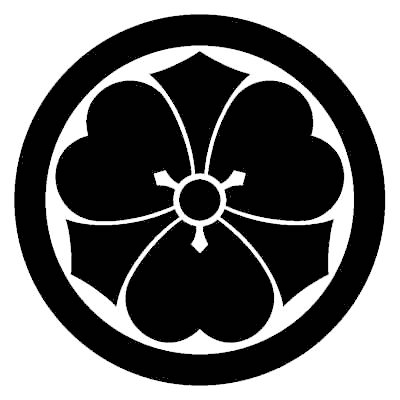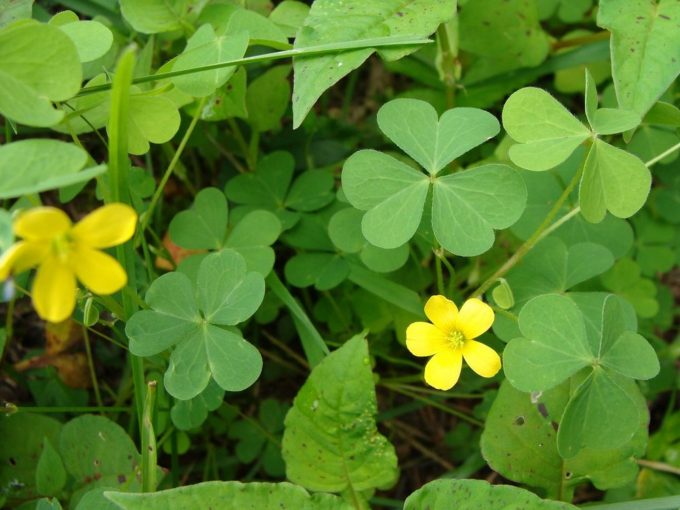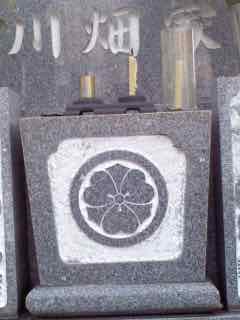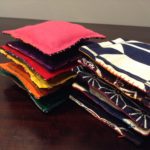
↑丸に剣かたばみ文は、こんなカタチです。『かたばみ』の三枚の葉っぱの隙間から、『剣』が三つ見えてます。それを『丸』で囲んでいます。
A sword-shaped creeping woodsorrel leaf on a circle.
丸に剣片喰文(まるにけんかたばみ)の意味・歴史?
カタバミの三葉を図案化し、紋章としたもの。片喰紋の葉はハート形で、特に女性に好まれるといわれる。
また、田のつく姓には片喰紋が多いとされる。
特に関西や北陸地方に多く見られるが、南九州や三陸には少ない。
出典:家紋ドットネット
片喰(かたばみ)の葉っぱのカタチ?

↑カタバミの葉は、ハート型が3つ合わさったカタチです。
This is how woodsorrel leaf look like.
墓石の描かれた、丸に剣片喰文(まるにけんかたばみ)

↑私の父方『川畑家』の墓石です。
My family tombstone in Japan.
『丸に剣かたばみ文』が描かれた布地/A sword-shaped creeping woodsorrel leaf on a circle printed on fabric

【色】濃紺、白
【素材】綿100%
【COLOUR】Dark navy, white
【MATERIAL】100% Cotton.
ENGLISH: Meaning & history of MARUNI KEN KATABAM (A sword-shaped creeping woodsorrel leaf on a circle)
In Japanese, this family crest is called, ‘Maruni ken katabami’.
Literal meaning of ‘Marumi Ken Katabami’ is ‘A sword-shaped creeping woodsorrel leaf on a circle’ in Japanese.
(…and this is my own family crest!)
This crest is called a
marunikatabami(丸に片喰 or 丸に酢漿草). The design is an encircled creeping woodsorrel flower. As such it is considered a variation of the more primary, and popular,katabami(片喰) crest, which is the same minus the circular border.The creeping woodsorrel grows extremely well as a wild weed; it is known for being difficult to uproot once it starts growing. The
katabamistyle crests originated from taking this property as a symbol for “propagating the family with many offsprings“. Medieval Japan (and today too) had a very strong belief in continuing the family line; thus, it is easy to imagine why this became a popular design of crests. Later on, the three leaves of thekatabamihave also been interpreted as symbolising mercy, wisdom and virtue.Because there was no limitations on how a clan chose their crests, the popular ones are shared by a great number of different families. Sometimes this happens when several clans descended from the same lineage; but often it is the result of nothing more than people picking the same design. This led to variations of the base design being adopted; both by clans wishing to make theirs more unique, as well as by individual members or branches of the same clan, in order to mark internal differences.
Apart from the
Source: https://history.stackexchange.com/questions/14178/meaning-of-samurai-crest-symbolmarunikatabami, other variations exist for thekatabamicrest. This includes thekenkatabami(剣片喰), which adds “leaves” to the flower indicating swords for a more military flavour, and thenanatsukatabami(七つ片喰), famously used by the Chōsokabe clans. Collectively the Katabami style crests are one of the five main crests of feudal Japan.
Variation of this pattern

the plain katabami crest: used by clans including the Nitta, the Hida, the Nakajō, the Taga, the Aki Fukuhara, the Sakai, the Shinshi, the Odachi, the Wada, the Kido, the Nakazawa, the Okada, and the Hosokawa Reizei.
Source: https://history.stackexchange.com/questions/14178/meaning-of-samurai-crest-symbol


the circled maru ni katabami crest: used by clans including the Naruse, the Hirose, the Adachi, the Itabe Okano, the Chimura, the Irie, the Tōdo, and the Morikawa
Source: https://history.stackexchange.com/questions/14178/meaning-of-samurai-crest-symbol


the seven flowered nanatsu katabami crest: used by the Chōsokabe clan.
Source: https://history.stackexchange.com/questions/14178/meaning-of-samurai-crest-symbol



コメント Leave your feedbacks